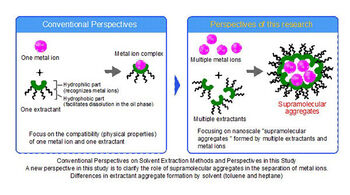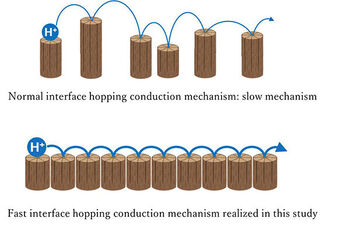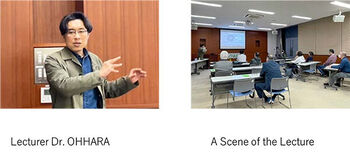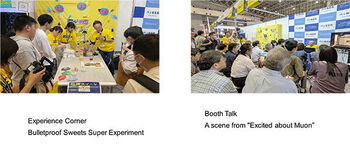J-PARC News May 2024 (Issue #229)
■Elucidating How Microbial Enzymes Degrade Natural Rubber by Visualizing Even Hydrogen Atoms
Gum Arabic, a natural rubber, is widely used in foods, cosmetics, and pharmaceuticals as a tablet coating. Using the Ibaraki biological crystal diffractometer (iBIX) for neutron structure analysis, we succeeded in determining the positions of the hydrogen atoms of the enzyme L-rhamnose-α-1,4-D-glucuronate lyase (FoRhmal), which can cleave the ends of the Gum Arabic molecule, and elucidated the cleavage mechanism. This achievement is expected to be applied to the analysis of the structure and physiological function of complex gum Arabic and the production of new oligosaccharides in the future.
■Successful Topological Number Switching among Various Spin Structures
-Expectations for Use as a New Information Carrier with Ultra-High Density
Conventional neutron diffraction experiments are not applicable to magnetic structure analysis of a gadolinium (Gd) compound because of its huge neutron absorption cross-section. We noticed on the fact that the absorption cross-section of Gd decreases rapidly when the neutron energy exceeds about 100 meV and succeeded for the first time in a neutron diffraction experiment.
Spin structures in a rare earth alloy (GdRu2Ge2) with a square lattice structure were observed with the High-Resolution Chopper Spectrometer "HRC" at MLF, and then, magnetic skyrmions (vortex-like spin structures of Gd atoms) with a tiny diameter of 2.7 nanometers were discovered. Furthermore, when the magnetic fields are externally applied to this material, it was also found that a variety of vortex winding patterns with different topological numbers such as "elliptical skyrnions," "melon-antimelon molecules" and "circular skyrmions" are produced dependently on the magnitude of the magnetic fields.
The switching among various topological spin structures by an external magnetic field is expected to contribute to the application of next-generation memory devices with ultra-small size and ultra-high density.
■New Perspectives for Advancing Resource Recycling Technology
-Control of Selectivity and Extraction Rate of Rare Metals by "Supramolecular Assemblies”
Solvent extraction is a separation and purification method that uses the solubility of a substance in either liquid phase between two immiscible liquid phases. In separating palladium (Pd) from neodymium (Nd), we found that the metal to be extracted and the extraction rate changed by changing the type of solvent used for the oil phase. We combined small-angle X-ray scattering and the soft interface analyzer (SOFIA, BL16) at J-PARC to clarify this phenomenon. Small-angle X-ray scattering has revealed that the properties of the supramolecular aggregates produced by extractants change depending on the solvent used for the oil phase. SOFIA revealed that the density of the extractant changes, and that the extraction rate of metal ions decreases when the extractant is sparse.
The results show the potential for new methods of separating metal ions by adding a supramolecular assembly perspective to conventional solvent extraction methods, as well as for the design of new extractants.
■Spontaneous Emergence of Chiral Crystal Structures and Antiferromagnetic Order
- Discovery of a novel structure in which time reversal symmetry and spatial symmetry are broken simultaneously
To develop a material that spontaneously undergoes a phase transition to a crystal structure with spatial symmetry breaking and can also have its time-reversal-symmetry breaking by magnetic ordering, the research group focused on the Remeika phase compound Nd3Rh4Sn13,
X-ray diffraction experiments at the KEK Photon Factory, and neutron scattering experiments at the J-PARC's single-crystal neutron diffractometer (BL18, SENJU), cold neutron disk chopper spectrometer (BL14, AMATERAS), and JRR-3 have revealed that this material undergoes a phase transition to a chiral crystal structure with spatial symmetry and further emerges an antiferromagnetic order with time-reversal symmetry breaking.
Research in new electronic and magnetic ordered states in chiral symmetric materials, such as in this study, is expected to lead to the development of materials science and future device and element applications.
■Utilizing the "arrangement" of molecules without relying on special "elements “
- Developed a polymer membrane that conducts hydrogen ions at high speed! - (April 26)
Although fluorine-rich polymer membranes have been used as hydrogen ion-conductive polymer membranes, which are important for hydrogen fuel cells, it is essential to develop a technology to create a fluorine-free hydrogen ion-conductive polymer membrane with equivalent properties in view of environmental issues. Therefore, focusing on the interface hopping conduction mechanism in polymer membranes, we created a polymer membrane with regular and dense arrangements of self-assembled molecules with sulfonate groups at the interface. The results of analysis of the hydrogen ion conductivity using a neutron beam at the BL02 Biomolecular Dynamics Spectrometer "DNA" at J-PARC revealed that fast hydrogen ion conduction occurred as conceived, overturning the conventional slow interfacial hopping conduction. Furthermore, it was found that all the water in the membrane is in a special state called bound water, which is advantageous for fuel cells because it does not freeze even at 0ᴼC and is resistant to evaporate even at high temperatures.
We believe that with further molecular improvements, it will be possible to create the ultimate hydrogen ion-conductive polymer membrane with a fluorine content of 0%, which currently still contains around 5%.
■Hello Science
True Molecular Shapes Derived from Neutrons and Single Crystals" (April 24)
Dr. OHHARA Takashi from the Neutron Science Section introduced single crystal structure analysis. Crystallography is a field that has won several Nobel Prizes, including one for showing that X-rays are electromagnetic waves. Crystals are formed by periodically arranged blocks of the same shape and reflect waves such as X-rays at specific crystalline planes. Single-crystal structure analysis is a technique that uses this principle to elucidate the arrangement of atoms in a crystal and to reveal the shape of the molecules in the crystal. Although X-rays are often used for this method, neutrons are also used to observe hydrogen atoms, which are difficult to observe with X-rays.
The MLF at J-PARC has two single-crystal diffractometers, one of which is SENJU, and Dr. OHHARA is responsible for it. The size of the sample used at SENJU is one order of magnitude smaller than usual single-crystal neutron structure analysis, and measurement can be performed in a variety of temperature environments ranging from below -270°C to over 500°C and under high magnetic fields. SENJU is optimized for research in physics and chemistry, and recently, structure determination of the essential molecules of glass, whose structure remained unknown for about 200 years after its discovery, by using SENJU.
Detailed structures of materials at the atomic level are essential information in physics, chemistry, biology, and other sciences. Single-crystal neutron structural analysis is the ultimate way to understand molecules' properties.
■KEK to exhibit at Niconico Ultra Conference 2024 (April 27-28)
KEK exhibited a booth titled "Super KEK" at the Niconico Cho-Kaigi Ultra Conference 2024 (real event) held at Makuhari Messe in Chiba, Japan, to introduce research being conducted at KEK, J-PARC and other facilities. The Niconico Cho-Kaigi is a cultural festival held both online and at the venue, is mainly organized by users of Niconico Douga Video, one of the largest video services in Japan, operated by Dwango Inc. This year, 125,362 people gathered at the real venue. This is the second time KEK has exhibited at the festival, following 2023.
In addition to the "Bulletproof Sweets Super Experiment" by Dr. SETO Hidenori of the Materials and Life Science Division at J-PARC, the “Super KEK Experience Corner” was set up to attract visitors’ interest, where they could experience first-hand the cloud chamber observations and experiments with the vacuum apparatus.
The "Super KEK Live Broadcast" was broadcast live online, and included many talks related to J-PARC, such as "Excited about Muons" by Dr. SHIMOMURA Koichiro, Deputy Director of the Materials and Life Science Division, "The Amazing J-PARC Accelerator" by Dr. OHTANI Masashi of the Accelerator Division, and "Amazing Neutrinos" by Dr. TADA Sho of the Particle and Nuclear Science Division.
The event was also a good opportunity for many people to learn about J-PARC through a stamp rally held jointly with Ibaraki Prefecture and Saza Coffee, and a super-sized lottery wheel in which visitors could solve a riddle to win J-PARC goods as prizes.
■J-PARC Sanpomichi ㊻ -The fresh green weather-
It is said that more than 70% of the information we receive comes from sight. Visible light, which can be seen with the naked eye, has wavelengths ranging from red (780 nm) to violet (380 nm). Green has a wavelength of 550 nm, which is in the middle range of visible light wavelength and is the color that causes the least strain on the eyes.
J-PARC is a facility that "looks at things to the utmost limit," akin to a giant microscope. Many protons are accelerated to nearly the speed of light, and so many secondary particles are produced. The secondary particles are then irradiated onto a sample to observe its structure and atomic movement, and to determine the identity of the secondary particles themselves. Of course, these "things" are invisible to the naked eye, so we must decipher the electronic data. To operate this huge and sensitive facility safely and not miss the slightest sign of the obtained data, we are sometimes forced to use our eyes and minds hard.
At this time of year, when you step out of the J-PARC building, the vivid greenery will catch your eyes. The fresh greenery spreading across the J-PARC grounds is a source of vitality for tomorrow, restoring the eyes and spirit that have been fatigued by staring at things to their limits.





